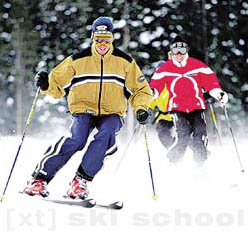|
Ski Teaching History
The need for skiing was born from the necessity of wartime logistics rather than a need for recreation. During WWII, the Tenth Mountain Division trained soldiers in the skills of wintertime survival and mountainside maneuverability. When the war was over, the soldiers returned the the U.S. and began using their training for recreation. The spin-off, luckily for us, was the development of ski areas nationwide. Teaching skiing began as a functional way of imparting survival skills. The goal of the early lesson -- get down the hill. This style of teaching focused on learning harder and harder movement patterns and specialized techniques. Skiers were constantly challenged to ski harder terrain even if they weren't quite ready. It was not a good time to be a tentative student. Since skiing is not a sport that can be learned in a season or even five seasons, the success rate was poor and many would-be skiers were driven from the sport. Skiing skills are gained slowly much like the way a tree grows -- a little each year.
Contemporary ski teaching philosophy
Ski teachers of today stress success and are trained to be patient with students. Teachers take a holistic, student-centered approach. Student backgrounds such as past experiences with sports and natural abilities are taken into account before selecting the lesson plan. The new approach works quite well as the flexible strategy can be applied with success to the slow learning, non-athletic beginner, or the fast paced professional athlete. Instructors today try to open their client's eyes to nature's beauty while getting exercise and recreation. Further, skiing usually takes place in a social setting and this includes the ski lesson. The most common lesson is the group beginner lesson. Here, as many as 14 people are stepping into skis for the first time. Instructors teaching these lessons should be aware of the anxiety associated with group dynamics in the initial bonding stage. The beginning of the lesson is the time for jocularity and name exchanges. These simple preliminaries seem almost magically to wipe away all shyness and pave the way for a positive learning environment.
The sport of skiing is looked upon today by instructors as a gift that can be given to sport-minded people, much as kernel of wisdom can be handed down from a paternal educator. This gift is invaluable as it can be a way to reduce stress, always bring a smile and break the ice in a social setting. There are many factors the teachers of today interpret before deciding on the best approach. If your instructor is really good he will have spoken a few words with each person in the group and decided the appropriate lesson format in the the first five minutes before the class starts. Todays teachers are decidedly holistic in their approach to ski teaching.
Practice makes perfect
It is every ski instructor's dream to bring their own excitement into the heart of their client. If your motivation to learn skiing is strong and you've already tasted the thrill of skiing as a beginner, you will easily advance every day while on the mountain. The key word here is "on the mountain." If you don't make an effort to get on the hill as much as possible, expect the fate of most skiers -- terminal intermediate abilities. This prognosis is fairly good because it will allow you to be equally matched with your peers and be able to enjoy a socially filled skiing lifestyle. The downside, of course, is that you will never be able to ski with the big boys who head immediately for the black diamonds (the runs rated for experts only). Also, you probably will never understand the saying, "there are no friends on a powder day." The only way to get really good is take lessons, voraciously read how-to books and the most important -- ski at least 20 days a year.
Tell the instructor your background and expectations
This holistic approach makes ski teachers take into account the student's history, natural talent, learning styles and motivation. If the instructor can keep this student centered approach and not just focus on the hard skills of physically learning the moves, he will be able to keep the student more interested in skiing -- possibly for a lifetime. This is how the best ski teachers think. If you can assist him by giving him the necessary information up front, he can quickly and accurately determine the best lesson for you.
Give him information like your skiing background: how many times you've gone, how many other sports you enjoy and what you expect from the lesson. These three simple pieces of information will insure the instructor understands where you are coming from and where you want to go.
Alpine Skiing School section in english version of WWW.SKI.BG is based on
"A Guide To Becoming An Expert: From First Time To A Lifetime"
by John Mukavitz Copyright © 1998

|


